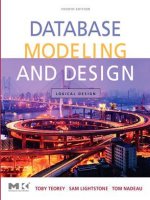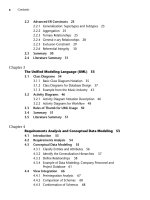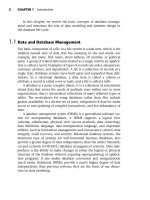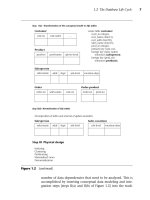Database Modeling & Design Fourth Edition- P10 pps
Bạn đang xem bản rút gọn của tài liệu. Xem và tải ngay bản đầy đủ của tài liệu tại đây (153.43 KB, 5 trang )
Teorey.book Page 32 Saturday, July 16, 2005 12:57 PM
33
3
The Unified Modeling
Language (UML)
he Unified Modeling Language (UML) is a graphical language for
communicating design specifications for software. The object-ori-
ented software development community created UML to meet the spe-
cial needs of describing object-oriented software design. UML has grown
into a standard for the design of digital systems in general.
There are a number of different types of UML diagrams serving vari-
ous purposes [Rumb05]. The class and activity diagram types are particu-
larly useful for discussing database design issues. UML class diagrams
capture the structural aspects found in database schemas. UML activity
diagrams facilitate discussion on the dynamic processes involved in
database design. This chapter is an overview of the syntax and semantics
of the UML class and activity diagram constructs used in this book.
These same concepts are useful for planning, documenting, discussing
and implementing databases. We are using UML 2.0, although for the
purposes of the class diagrams and activity diagrams shown in this book,
if you are familiar with UML 1.4 or 1.5 you will probably not see any dif-
ferences.
UML class diagrams and entity-relationship (ER) models [Chen,
1976; Chen, 1987] are similar in both form and semantics. The original
creators of UML point out the influence of ER models on the origins of
class diagrams [Rumbaugh, Jacobson, and Booch, 2005]. The influence
of UML has in turn affected the database community. Class diagrams
T
Teorey.book Page 33 Saturday, July 16, 2005 12:57 PM
34 CHAPTER 3 The Unified Modeling Language (UML)
now appear frequently in the database literature to describe database
schemas.
UML activity diagrams are similar in purpose to flowcharts. Processes
are partitioned into constituent activities along with control flow speci-
fications.
This chapter is organized into three sections. Section 3.l presents
class diagram notation, along with examples. Section 3.2 covers activity
diagram notation, along with illustrative examples. Section 3.3 con-
cludes with a few rules of thumb for UML usage.
3.1 Class Diagrams
A class is a descriptor for a set of objects that share some attributes and/
or operations. We conceptualize classes of objects in our everyday lives.
For example, a car has attributes, such as vehicle identification number
(VIN) and mileage. A car also has operations, such as accelerate and
brake. All cars have these attributes and operations. Individual cars dif-
fer in the details. A given car has its own values for VIN and mileage.
For example, a given car might have VIN 1NXBR32ES3Z126369 and a
mileage of 22,137 miles. Individual cars are objects that are instances of
the class “Car.”
Classes and objects are a natural way of conceptualizing the world
around us. The concepts of classes and objects are also the paradigms
that form the foundation of object-oriented programming. The develop-
ment of object-oriented programming led to the need for a language to
describe object-oriented design, giving rise to UML.
There is a close correspondence between class diagrams in UML and
ER diagrams. Classes are analogous to entities. Database schemas can
be diagrammed using UML. It is possible to conceptualize a database
table as a class. The columns in the table are the attributes, and the
rows are objects of that class. For example, we could have a table
named “Car” with columns named “vin” and “mileage.” Each row in
the table would have values for these columns, representing an indi-
vidual car. A given car might be represented by a row with the value
“1NXBR32ES3Z126369” in the vin column, and 22,137 in the mileage
column.
The major difference between classes and entities is the lack of oper-
ations in entities. Note that the term operation is used here in the UML
sense of the word. Stored procedures, functions, triggers, and constraints
are forms of named behavior that can be defined in databases; however
Teorey.book Page 34 Saturday, July 16, 2005 12:57 PM
3.1 Class Diagrams 35
these are not associated with the behavior of individual rows. The term
operations in UML refers to the methods inherent in classes of objects.
These behaviors are not stored in the definition of rows within the data-
base. There are no operations named “accelerate” or “brake” associated
with rows in our “Car” table. Classes can be shown with attributes and
no operations in UML, which is the typical usage for database schemas.
3.1.1 Basic Class Diagram Notation
The top of Figure 3.1 illustrates the UML syntax for a class, showing
both attributes and operations. It is also possible to include user-defined
named compartments, such as responsibilities. We will focus on the class
name, attributes, and operations compartments. The UML icon for a
class is a rectangle. When the class is shown with attributes and opera-
tions, the rectangle is subdivided into three horizontal compartments.
The top compartment contains the class name, centered in bold face,
beginning with a capital letter. Typically, class names are nouns. The
middle compartment contains attribute names, left-justified in regular
face, beginning with a lowercase letter. The bottom compartment con-
tains operation names, left-justified in regular face, beginning with a
lowercase letter, ending with a parenthetical expression. The parentheses
may contain arguments for the operation.
The class notation has some variations reflecting emphasis. Classes
can be written without the attribute compartment and/or the operations
compartment. Operations are important in software. If the software
designer wishes to focus on the operations, the class can be shown with
only the class name and operations compartments. Showing operations
and hiding attributes is a very common syntax used by software design-
ers. Database designers, on the other hand, do not generally deal with
class operations; however, the attributes are of paramount importance.
The needs of the database designer can be met by writing the class with
only the class name and attribute compartments showing. Hiding opera-
tions and showing attributes is an uncommon syntax for a software
designer, but it is common for database design. Lastly, in high-level dia-
grams, it is often desirable to illustrate the relationships of the classes
without becoming entangled in the details of the attributes and opera-
tions. Classes can be written with just the class name compartment
when simplicity is desired.
Various types of relationships may exist between classes. Associations
are one type of relationship. The most generic form of association is
drawn with a line connecting two classes. For example, in Figure 3.1
Teorey.book Page 35 Saturday, July 16, 2005 12:57 PM
36 CHAPTER 3 The Unified Modeling Language (UML)
there is an association between the class “Car” and the class named
“Driver.”
A few types of associations, such as aggregation and composition, are
very common. UML has designated symbols for these associations.
Aggregation indicates “part of” associations, where the parts have an
independent existence. For example, a Car may be part of a Car Pool.
The Car also exists on its own, independent of any Car Pool. Another
distinguishing feature of aggregation is that the part may be shared
Figure 3.1 Basic UML class diagram constructs
Class Name
attribute1
attribute2
operation1()
operation2()
Car
vin
mileage
accelerate()
brake()
Car
accelerate()
brake()
Car
vin
mileage
Car
Notation and Example
Notational Variations
Emphasizing Operations
Emphasizing Attributes
Emphasizing Class
R
elationships
Classes
Association
Generalization
Aggregation
Composition
Car Driver
CarSedan
Car Frame
CarCar Pool
Teorey.book Page 36 Saturday, July 16, 2005 12:57 PM









